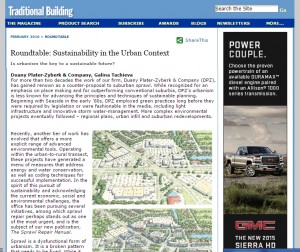For more than two decades the work of our firm, Duany Plater-Zyberk & Company (DPZ), has gained renown as a counter-proposal to suburban sprawl. While recognized for an emphasis on place making and for outperforming conventional suburbia, DPZ’s urbanism is less known for advancing the principles and techniques of sustainable planning. Beginning with Seaside in the early ’80s, DPZ employed green practices long before they were required by legislation or were fashionable in the media, including light infrastructure and innovative storm water-management. More complex environmental projects eventually followed – regional plans, urban infill and suburban redevelopments.
The pair of aerials demonstrates the transformation of a conventional strip shopping center into a mixed-use, pedestrian-friendly town center that will serve the surrounding suburban communities. The existing big boxes and drive-through restaurants are embedded in fine-grain fabric of urban blocks, centered on a new square.
Recently, another tier of work has evolved that offers a more explicit range of advanced environmental tools. Operating within the urban-to-rural transect, these projects have generated a menu of measures that address energy and water conservation, as well as coding techniques for successful implementation. In the spirit of this pursuit of sustainability and acknowledging the current economic, social and environmental challenges, the office has been pursuing several initiatives, among which sprawl repair perhaps stands out as one of the most urgent, and is the subject of our new publication, The Sprawl Repair Manual.
